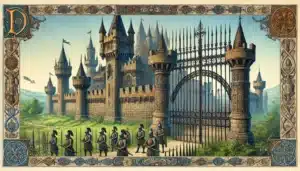Securing your home is more than just an investment in your property; it’s a commitment to the safety and peace of mind for you and your family. In the quest to fortify our homes, the choice of fencing plays a pivotal role. While there are numerous materials available, two popular options often come to the forefront: wrought iron and vinyl. Each offers distinct features and aesthetic appeals, but when it comes to security, a deeper understanding is crucial.
This post is dedicated to all homeowners, particularly those who, like myself, come from a blue-collar background and understand the value of hard work and secure living. We will delve into the specific security aspects of wrought iron and vinyl fencing. Our focus will not be on the cost, durability, or aesthetic appeal of these materials; instead, we will conduct a thorough analysis of how these fencing options stand up to security challenges.
Wrought iron, with its robust and often imposing presence, has been a traditional choice for those seeking a combination of elegance and strength. On the other hand, vinyl fencing, known for its versatility and low maintenance, has emerged as a popular alternative in modern homes. But how do these materials fare when tested against potential security breaches? That’s the question we aim to answer.
By the end of this post, you will have a clearer understanding of which fencing material might best suit your security needs, helping you make an informed decision for your home’s safety. Let’s embark on this journey of exploration, comparing wrought iron and vinyl fencing, not just as barriers, but as guardians of your home.
Wrought Iron Fencing
A. Description and Characteristics
- Physical Composition and Typical Design Features Wrought iron fencing is renowned for its strength and durability. It is made from iron that is heated and then worked into various shapes and designs, often featuring ornate patterns that add to its visual appeal. This type of fencing usually comes in a variety of styles, from simple, straight bars to intricate designs with curves and flourishes. The thickness of the bars and the complexity of the designs can vary, but all wrought iron fences share a common characteristic of solid construction and substantial weight.
- Visibility Aspects Through the Fence One of the unique features of wrought iron fencing is its ability to provide security without sacrificing visibility. The spacing between the bars in most designs is such that it allows clear sightlines. This means homeowners can see through the fence, which is beneficial for surveillance and observing any activity outside the boundary. It also means that the aesthetic appeal of a property is not diminished by a solid barrier, as is often the case with other fencing types.
B. Security Advantages
- Strength and Resistance to Forced Entry The primary security advantage of wrought iron is its sheer strength. It is extremely difficult to breach a wrought iron fence. Its robustness makes it resistant to ramming or brute force attacks. This characteristic alone makes it a formidable barrier against intruders.
- Difficulty in Cutting or Breaking Unlike some other fencing materials, wrought iron is not easily cut or broken. The effort required to cut through the thick iron bars is significant, and it typically requires specialized tools. This attribute acts as a strong deterrent to potential intruders who are looking for an easy target.
- Height and Deterrent Factor for Intruders Wrought iron fences can be constructed at various heights, but they are often tall, which adds to their security value. The height not only makes it difficult for intruders to climb over but also imparts an imposing presence. Many wrought iron fences feature pointed or sharp finials at the top, which further discourage attempts to scale them.
C. Security Limitations
- Rust and Maintenance Issues Affecting Security The major drawback of wrought iron is its susceptibility to rust. If not properly maintained, rust can weaken the fence’s structure over time, potentially compromising its security integrity. Regular maintenance, including painting or applying rust-proof coatings, is necessary to preserve both its appearance and strength.
- Climbing Considerations Due to Design Features While the height and design of wrought iron fencing can act as a deterrent, some designs might inadvertently aid climbers. For instance, horizontal bars or ornate designs can provide footholds for intruders skilled in climbing. This is a crucial consideration when choosing the design of a wrought iron fence for security purposes. Selecting designs with fewer horizontal elements and more vertical lines can mitigate this risk.
Vinyl Fencing
A. Description and Characteristics
- Physical Composition and Common Styles Vinyl fencing, made from a type of plastic called PVC (polyvinyl chloride), has gained popularity due to its versatility and ease of maintenance. This material is molded into various shapes and sizes, allowing for a wide range of styles, from picket fences to privacy fences. Vinyl fences often mimic the appearance of traditional wood fences but come in a broader range of colors and finishes. They are lightweight compared to wrought iron and are known for their resilience against elements like rot and pests, which typically affect wooden fences.
- Privacy Aspects Due to Solid Panels One of the defining characteristics of many vinyl fence styles is the solid panel design. Unlike wrought iron, which is more open, vinyl fencing can provide complete privacy. This is particularly beneficial for those who value their seclusion or wish to shield their property from outside view. It can also be a security feature, as it prevents potential intruders from easily seeing into your property to assess vulnerabilities or valuable items.
B. Security Advantages
- Resistance to Certain Weather Conditions Vinyl fencing stands out for its resistance to various weather conditions. It does not warp, rot, or rust when exposed to moisture, and its color does not fade easily under sunlight, thanks to UV inhibitors in the material. This durability means that vinyl fencing maintains its structural integrity over time, making it a reliable barrier against intruders.
- Difficulty in Dismantling or Removing Panels The way vinyl fencing is constructed makes it challenging to dismantle or remove panels quickly. The panels often interlock and are anchored securely into the ground with strong posts. This design means that taking apart a vinyl fence for unauthorized entry requires time and effort, acting as a deterrent to potential intruders.
- Low Maintenance and Long-Term Stability Vinyl fences require minimal maintenance to retain their appearance and function. They do not need painting or sealing and can be cleaned easily with water. This low maintenance aspect ensures that the fence remains a stable and reliable security barrier over the years without the need for frequent inspections or repairs.
C. Security Limitations
- Potential for Cutting or Breaking with Force Despite its durability, vinyl is not as strong as wrought iron and can be susceptible to damage if enough force is applied. It can be cut or broken, especially when targeted with specific tools. This aspect might make it a less intimidating option for securing a property against determined intruders.
- Lack of Intimidating Presence Compared to Wrought Iron While vinyl fencing is functional and aesthetically versatile, it lacks the imposing presence that wrought iron fences often have. This lack of intimidation can be a downside in terms of security, as it might not deter potential intruders as effectively. The appearance of vinyl fencing is generally more welcoming or neutral, which may not convey the same level of security as the more formidable wrought iron.
Comparative Analysis
A. Direct Comparison in Terms of Security
- Impact Resistance and Potential for Breaching
- Wrought Iron: Wrought iron stands out for its high impact resistance. Its dense, solid structure makes it highly resistant to breaching attempts such as ramming or heavy blows. The strength of wrought iron is a significant deterrent for anyone attempting to forcefully enter a property.
- Vinyl: While vinyl is durable in many aspects, it does not match the impact resistance of wrought iron. It can withstand normal environmental stresses but is more vulnerable to forceful impacts. This makes vinyl fences more susceptible to breaching, particularly when targeted with specific tools or brute force.
- Height and Climbability for Deterrence
- Wrought Iron: The height of wrought iron fences can be a major deterrent, and their design often includes features that make climbing difficult, such as pointed tops or closely spaced bars. The ability to customize the design can further enhance these anti-climbing features.
- Vinyl: Vinyl fencing can also be constructed to various heights, but it typically doesn’t offer the same anti-climbing features as wrought iron. Its smooth surface can make it difficult to climb, but it lacks additional deterrents like sharp tops. However, the solid panels of vinyl fencing can make it challenging for intruders to find footholds.
- Visibility and Surveillance Capabilities
- Wrought Iron: The open design of wrought iron fencing offers excellent visibility, allowing homeowners to observe the exterior of their property easily. This can be a critical factor in surveillance and early detection of potential threats.
- Vinyl: Vinyl fencing, particularly those styles with solid panels, limits visibility. This can be advantageous for privacy but is a drawback for surveillance purposes. It can obstruct views of the property perimeter, potentially hindering the detection of trespassers.
B. Ideal Scenarios for Each Type
- When to Choose Wrought Iron for Security
- Wrought iron is ideal for properties where maximum security is a priority. It’s especially suitable for areas with higher crime rates or where the visual deterrent of a robust fence is important. Wrought iron is also a great choice for those who want to balance security with aesthetic appeal, and for properties where maintaining visibility is crucial, such as businesses or homes with large yards that require monitoring.
- Situations Where Vinyl Fencing Might be More Secure
- Vinyl fencing is a good choice in environments where privacy is a key concern. It’s well-suited for residential areas where the primary security threat is not forceful entry but rather more casual trespassing or where maintaining a certain aesthetic is important. Vinyl is also advantageous in coastal or humid climates, where the corrosion resistance of the material ensures long-term durability without the constant maintenance that wrought iron requires. Additionally, for homeowners looking for a secure option with lower maintenance, vinyl is an excellent choice.
Conclusion
A. Recap of Key Security Points for Both Materials
- Wrought Iron: This material stands out for its strength, impact resistance, and deterrent presence. Its design offers excellent visibility for surveillance, but it requires regular maintenance to prevent rust and can be climbable depending on the design.
- Vinyl: Vinyl fencing provides great privacy and is resistant to various weather conditions, requiring minimal maintenance. However, it is less impact-resistant compared to wrought iron and offers limited visibility for surveillance purposes.
B. Final Thoughts on Choosing the Right Material for Home Security Choosing the right fencing material for your home security is a decision that balances various factors: the level of security required, maintenance capabilities, aesthetic preferences, and environmental conditions. Wrought iron is the go-to choice for maximum security and visibility, while vinyl is preferable for privacy and low maintenance. It’s crucial to weigh these factors against your specific security needs and environmental conditions.
C. Encouragement for Further Consultation with Security Professionals While this guide provides a comprehensive comparison, every home and situation is unique. I encourage you to consult with security professionals who can offer personalized advice based on your specific circumstances. These experts can assess your property, consider local safety concerns, and recommend the best fencing solution for your home.
VI. Additional Resources
A. Links to More Detailed Articles on Fencing Materials
- Fencing Material Comparison Guide
- Home Security Fencing Options
- Advantages and Disadvantages of Different Fence Types
B. Recommendations for Security Enhancements Beyond Fencing In addition to fencing, consider other security enhancements for your home. These might include security cameras, motion sensors, alarm systems, and outdoor lighting. Combining these elements with the right fence can create a comprehensive security system for your home. For more information on these options, check out the following resources:
Remember, the safety of your home and family is paramount, and the right fencing can play a crucial role in ensuring that security.



